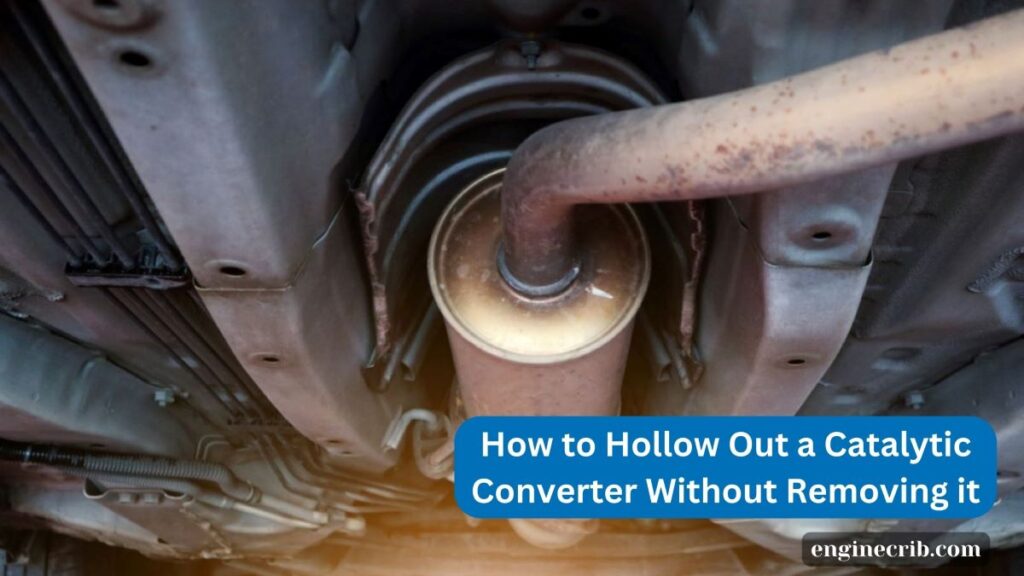The catalytic converter is an essential component of a vehicle’s exhaust system that helps reduce harmful emissions. If you tamper with or remove it, the vehicle will emit pollutants that can harm the environment and human health.
In order words, hollowing out a catalytic converter without removing it is not only illegal but also extremely dangerous for the environment and human health. Although there are cases in which you might need to replace your cat, so you will need to remove it from the exhaust system.
In this post, we will show you how to hollow out a catalytic converter without removing it and the pros and cons of hollowing a catalytic converter.

Table of Contents
What is a Catalytic Converter?
A catalytic converter is an emissions control device that is installed in the exhaust system of a gasoline or diesel-powered vehicle. Its primary function is to convert harmful pollutants in the engine exhaust into less harmful substances before releasing them into the atmosphere.
The catalytic converter contains a ceramic or metallic honeycomb structure coated with catalysts, such as platinum and rhodium. As exhaust gases pass through the honeycomb structure, the catalysts trigger chemical reactions that convert carbon monoxide (CO) into carbon dioxide (CO2), hydrocarbons (HC) into water vapor (H2O) and carbon dioxide (CO2), and nitrogen oxides (NOx) into nitrogen gas (N2) and water vapor (H2O).
By reducing the level of harmful emissions, catalytic converters help to improve air quality and reduce environmental pollution. Many countries around the world have laws mandating the use of catalytic converters in vehicles.
Hollowing a Catalytic Converter Without Removing it
1. Lift the Car
Use the jack to lift your car, then wait for it to cool before continuing.
2. Locate the Catalytic Converter
You need to know where your catalytic converter is located before you can go ahead with the procedure. It is usually located in your vehicle’s exhaust system.
3. Bend the Cut Flap
Carefully avoid completely cutting off the cut flap as you use a crowbar to bend it down. After that, form a proper flap at the base of the converter using the wheel grinder or ethane welding torch.
4. Link the Seal Kit and Flap
Use the arc welder to melt the steel wire. After that, while the melted metal is still hot, reshape it with the putty steel knife. Make sure you are wearing your welding gloves and goggles.
5. Break the Converter Covering
Use the hammer to break the honeycomb-like structure gently, being careful not to damage it. The chisel can also be used to help with the task.
6. Close the flap
After removing the converter cover, you can use the pliers to bend the flap backwards to close the gap. To prevent leaks, weld the flap to close the opening.
Pros of Hollowing Out a Catalytic Converter
1. The Sound of the Exhaust
Gases released from the engine during fuel combustion have a different impact when a catalyst converter is hollowed out. Since the catalytic converter muffles exhaust noise, you could compare it to removing the muffler from your car. Some individuals think this is cool as the sound increases in volume and strength.
2. Generation of More Horsepower
Depending on the model of your car, hollowing out the catalytic converter can result in an increase in horsepower. It is possible because a gutted catalytic converter causes the engine to experience back pressure, which lowers engine power.
3. Lower Temperature
Your engine has to work harder to produce power because of the catalytic converter, which produces more heat. However, by hollowing out the catalytic converter, this additional work is removed and the operating temperature is lowered. Furthermore, friction and load are removed, which lowers the tendency for wear and tear.
4. Better Gas Mileage
Fuel consumption increases with engine workload. Because of this, hollowing out the catalytic converter increases your car’s fuel economy, which is very cost-effective for you.
Cons of Hollowing Out a Catalytic Converter
1. It is Illegal
Most U.S. states prohibit hollowing out a catalytic converter, and there are procedures you must follow to remove it lawfully. As a result, if you break the law, you will be penalized severely and possibly disqualified from driving for a while.
2. Damage your Vehicle
When you set off a fault code in your car, hollowing out a catalytic converter might go terribly wrong. The heads-up display on your car will also turn on the engine check light. The warning light may occasionally give you a false alarm as well. There is a good chance that this problem won’t go away, even though you can solve it.
3. Environmental Impact
Due to the emission of unconverted gases, there are environmental impacts when the catalytic converter is hollow. Moreover, in addition to headaches, this may result in other health issues. Additionally, it advances the conversation about issues such as acid rain, global warming, and other environmental issues. When the gases are inhaled, they can also directly affect people.
4. Leakages
After the catalytic converter has been hollowed out, there may be some leaks because of broken parts. These damaged components could leave a gap where gas and air could leak. And when you start your car, you’ll notice loud echoes, hissing, or vibrations that are signs of a leak.
Read: Driver Alert Warning Rest Suggested [All you Need to Know]
Conclusion
Hollowing out a catalytic converter without removing it is an illegal and highly damaging practice that involves removing the inner substrate of the converter to increase the vehicle’s performance. The process leads to the release of harmful emissions, which not only violate environmental regulations but also pose a significant health risk to the public.
Catalytic converters play a crucial role in reducing the number of harmful pollutants that cars emit into the environment, and hollowing them out negates all their benefits. It is essential to follow environmental regulations and support efforts to reduce pollution to preserve our planet’s health and safety for future generations.